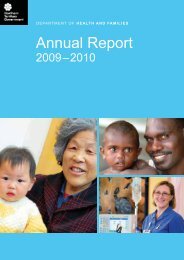PCD Strategy Evaluation 2007.pdf - NT Health Digital Library ...
PCD Strategy Evaluation 2007.pdf - NT Health Digital Library ...
PCD Strategy Evaluation 2007.pdf - NT Health Digital Library ...
You also want an ePaper? Increase the reach of your titles
YUMPU automatically turns print PDFs into web optimized ePapers that Google loves.
DiscussionThe need to develop a skilled workforce is a priority contained in the Building <strong>Health</strong>yCommunities Policy (23) . Ensuring all staff in community services undertake induction, orientationand training is a key commitment identified. The chronic disease training needs of the remoteand rural workforce have been clearly articulated in two particular surveys (35, 46) . Though there isa mismatch between evidence for what is required to improve the health of the population andthe capacity of the workforce to act on the evidence (47) .Orientation and continuing education have been an important priority of the <strong>NT</strong><strong>PCD</strong>S and the<strong>PCD</strong>S. Staff who attended these training programs have reported benefits, however they arecompromised by continued high turnover rates, the demands of acute care, and a focus that ison the needs of remote area nurses. Feedback on the chronic disease module has revealed thatthere is a lot of information to cover in the one-week program and that more information isrequired, particularly in the areas of renal and cardiac management for remote area staff, as wellas the need to also include mental illness. The Pathways Program and the renal services programhave both reported an increase in staff retention. The renal program has also reduced inpatientadmissions.The <strong>NT</strong> Pathways Program is a useful strategy to assist staff to understand the causes andmanagement of chronic disease. However attendance is limited to mainly remote areas nursesmany of whom are unable to access these programs. Due to insufficient data it was unclear howmany people did not access, or were delayed in accessing, the courses. This depended on theirtime of appointment, length of contract, and the sufficiency of staff remaining at the healthcentre to provide a service. Some staff in Central Australia felt that the change to a Territorywide program had resulted in local information being removed from the program, which made itless useful. There were also problems with the delivery of some of the modules in CentralAustralia, leading to the view that some staff were less prepared than they had been in the past.Clinical staff attending these courses have frequently been found to have limited knowledgeabout a systems approach, care planning, working effectively in cross cultural teams and using apopulation health approach (35, 48) . This process of training about a systems approach mustcontinue and innovative ways to apply this knowledge should be investigated as the workforce inthe Territory has a rapid staff turnover rate. Despite this there is support for workforcedevelopment though it is often difficult to allow clinic staff to be released from clinical activitiesand support them with relief when training activities are planned due to the acute care needs ofthe populations they are serving.Chapter 3: Progress Against <strong>PCD</strong>S Objectives – <strong>Evaluation</strong> of the <strong>NT</strong> Preventable Chronic Disease <strong>Strategy</strong> 2007 36
















